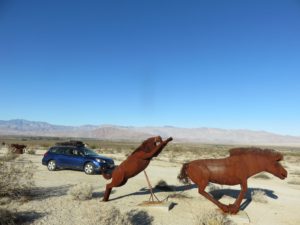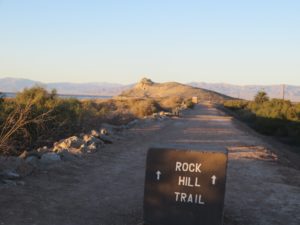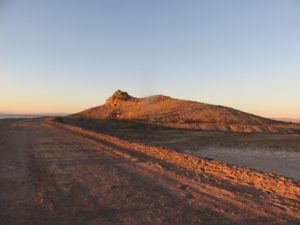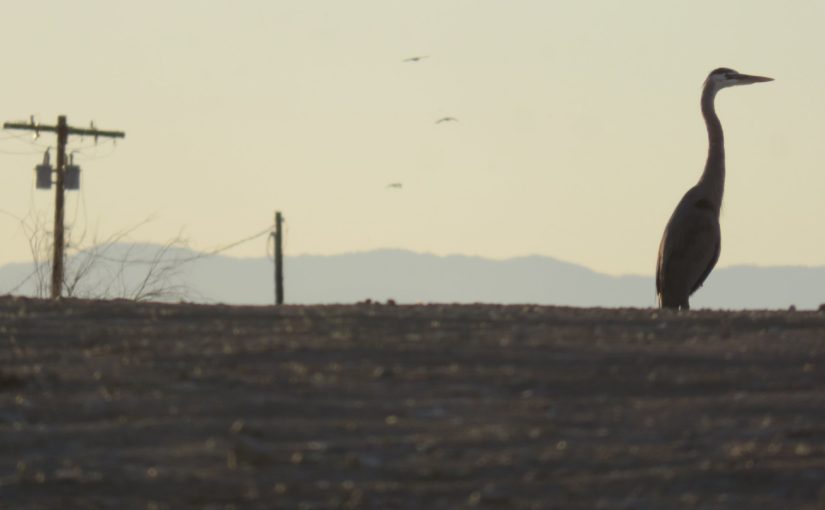While in Southern California for the season, I decided to do a run over to the Sonny Bono Salton Sea National Wildlife Refuge. I had recently discovered that a small series of active volcanoes–the Salton Buttes–were located within and nearby the wildlife refuge, and this became a goal of this adventure.
I started the day on Saturday by meeting up with friends in the North County area of San Diego. Unfortunately, we ended up getting going quite late, which would hinder the rest of the day’s plans, but we set out nonetheless.
 We drove out on the freeway, headed over the mountains and into the desert around Borrego Springs. Although this route was longer in time and distance than some other alternatives, it would be the most interesting. We even accidentally stumbled upon the steel sculptures lining the desert just outside of town, stopping to view them briefly. Unfortunately, with time already running low, we couldn’t hang out long before turning out and heading further East.
We drove out on the freeway, headed over the mountains and into the desert around Borrego Springs. Although this route was longer in time and distance than some other alternatives, it would be the most interesting. We even accidentally stumbled upon the steel sculptures lining the desert just outside of town, stopping to view them briefly. Unfortunately, with time already running low, we couldn’t hang out long before turning out and heading further East.
Somehow, I had never been to the Southern shores of the Salton Sea, at the Sonny Bono Salton Sea National Wildlife Refuge. However, while researching volcanoes recently, I came across the existence of the Salton Buttes. These are a series of small, active volcanoes. They last erupted about 1800 years ago, and there is considered be a realistic threat of them erupting again in the future. Even now, several geothermally active features exist in the area, fueling a number of geothermal energy plants that we passed as we drove through the area.
 Throughout the drive, the Salton Buttes were not easily visible. Most don’t even peak above sea level–the entire basin being well below sea level, of course. However, as we drove into the Wildlife Refuge parking lot, Rock Hill came into view, and we quickly decided to make the one mile hike to the summit. It’s a mostly flat hike, mostly highlighting the wildlife that calls this area home–namely the diversity of birds.
Throughout the drive, the Salton Buttes were not easily visible. Most don’t even peak above sea level–the entire basin being well below sea level, of course. However, as we drove into the Wildlife Refuge parking lot, Rock Hill came into view, and we quickly decided to make the one mile hike to the summit. It’s a mostly flat hike, mostly highlighting the wildlife that calls this area home–namely the diversity of birds.
 As we reached the base of the hill, there was one board describing the geothermal natural history of the area, although it hardly emphasized that we were standing on and beginning to climb up an active volcano. Nonetheless, we made the way to the summit, knowing simply from my own previous research of what we we were walking up.
As we reached the base of the hill, there was one board describing the geothermal natural history of the area, although it hardly emphasized that we were standing on and beginning to climb up an active volcano. Nonetheless, we made the way to the summit, knowing simply from my own previous research of what we we were walking up.
Tons of pumice and obsidian rock were all over the hill. It appeared to be far from the intact status of lava flows and such that I have seen at other parks across the country, but it was also accompanied by lovely views and horrid smells from the Salton Sea, along with flocks of birds and other wildlife.
As we continued back to the car, the sun set and so we ended up deciding to save the rest of the buttes and other geothermal features for another day. Until then, it was a pretty lovely place to visit!



















